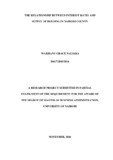| dc.description.abstract | This project set out to identify the relationship that existed between interest rates and supply of housing in Nairobi County over the period between 2010 and 2015. To attain the study objective, data covering the period between 2010 and 2015 was acquired from the central bank quarterly reports and Hass consult house sales survey reports. This data was cleaned and organised in a manner that made it possible for analysis by SPSS version 20. The study was undertaken using the quarterly average house sales in Nairobi county, quarterly average lending rates, quarterly GDP rates and quarterly inflation rates data using correlation and regression analysis. The study employed various techniques including trend analysis and multiple regression analysis. Statistical tests for significance were done at 95% confidence level. Regression analysis was done considering heteroscedasticity errors to analyse the relationship between interest rates over the study period. The results indicated by the R square value was 0.041 showed that there was variation of 4.1% in the supply of houses in Nairobi County as a result to changes in inflation rates, GDP growth rate and lending rates at 99% confidence interval (p<0.01). The R value, the correlation coefficient, indicates the existence of and nature of the relationship between the variables under study. The results demonstrated that there existed a positive correlation between the variables under study as revealed by the R value of 0.203. The implication of the findings is that interest rates have a little but significant relationship with the supply of housing in Nairobi County. As a result, alteration in the interest rates will have an effect on the unit house sales thus the supply of housing. This study findings compels the government to give price subsidies and tax exemptions or allowances on construction materials to companies engaged in housing construction. This would guarantee increase in house supply to meet the ever increasing demand for housing. Additionally, financial support programmes that will enable supply of affordable shelter to residents of Nairobi County should be put in place. Also, sound macroeconomic environment complemented by the right fiscal and monetary policies to be implemented to ensure growth in income which will result in not only increased supply of housing but also the ability of residents to afford the housing. Further, the government through mandated state bodies should establish measures to maintain sustainable inflation rates. Low inflation rates results in increased housing supply by making products, in this case building material, more affordable which in turn translates to reduced cost of construction and acquisition of new houses | en_US |



